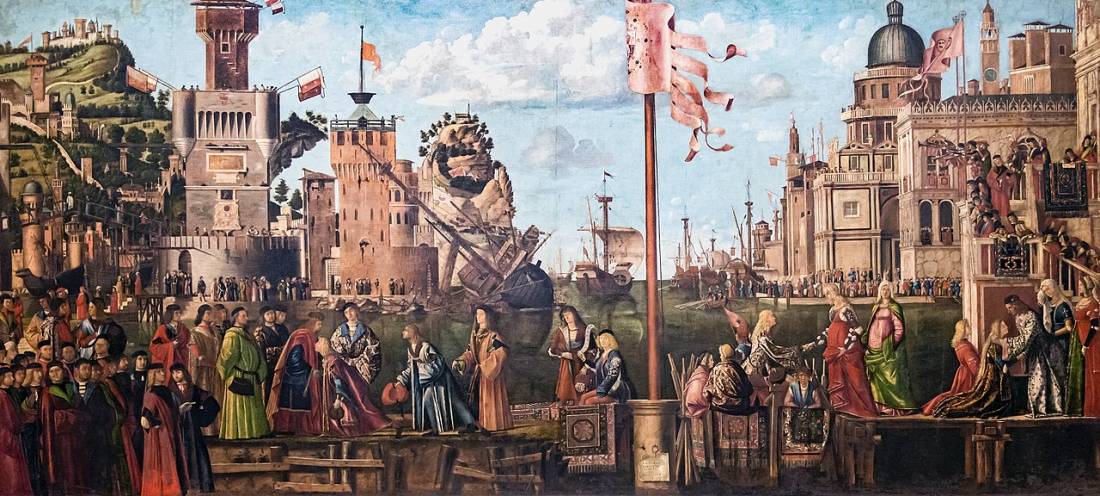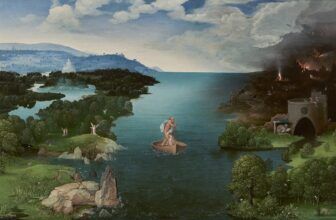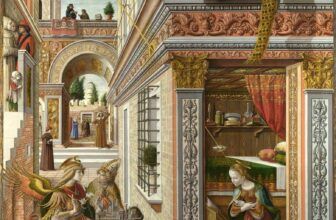
The Legend of Saint Ursula: A Deep Analysis and Meaning
The Italian Renaissance was a period when art and faith merged to create some of the most extraordinary works in human history. Among these treasures is Vittore Carpaccio’s cycle of paintings known as The Legend of Saint Ursula, produced between 1490 and 1496. This extraordinary series, commissioned for the Scuola di Sant’Orsola in Venice, tells the story of the Christian martyr Saint Ursula and her companions. Rich with symbolism, narrative detail, and Venetian grandeur, Carpaccio’s cycle stands as one of the greatest achievements of Renaissance narrative painting.
In this essay, we will explore the background of the paintings, their commission and execution, the story of Saint Ursula as represented by Carpaccio, the symbolism within the works, the artistic techniques employed, and their significance in Renaissance art. We will also consider the paintings’ current location and their lasting legacy in art history.
Vittore Carpaccio (c. 1465 – 1525/1526) was a Venetian painter of the Renaissance, contemporary with the more famous Bellini family and an older figure to whom artists like Titian and Tintoretto would later look. Carpaccio is best remembered today for his grand narrative cycles painted for Venetian confraternities, or scuole.
Carpaccio’s style is distinguished by vivid storytelling, a theatrical sense of composition, luminous color, and a remarkable eye for architectural detail. His paintings often incorporate elements of daily Venetian life into sacred or legendary stories, creating a blend of the contemporary and the spiritual. This unique characteristic makes his works both visually rich and culturally invaluable as documents of late 15th-century Venice.
The Legend of Saint Ursula cycle was commissioned by the Scuola di Sant’Orsola, a Venetian confraternity devoted to the saint. Such confraternities were religious brotherhoods that played an important role in civic and devotional life, and they often commissioned elaborate cycles of paintings to decorate their meeting halls.
Carpaccio painted the Ursula cycle between 1490 and 1496, producing nine large canvases. These paintings narrate the story of Saint Ursula, based on the Legenda Aurea (The Golden Legend), a medieval compilation of saints’ lives that had enormous influence on Christian devotion and art.
The Story of Saint Ursula
According to legend, Saint Ursula was a Christian princess of Brittany (or sometimes England) who vowed to remain a virgin and devote herself to God. Her father promised her in marriage to a pagan prince, but Ursula set conditions: before marriage, she and her companions should be allowed to embark on a pilgrimage across Europe, and her fiancé should convert to Christianity.
Ursula set sail with 11,000 virgins (a number later believed to be symbolic or a mistranslation), and their travels took them across Europe to Rome. On the return journey, they encountered the Huns, who massacred her companions. Ursula herself was offered marriage by the Hun chieftain, but she refused, remaining faithful to her vow of virginity. For her defiance, she was killed, achieving the crown of martyrdom.
The Legend of Saint Ursula: A Narrative in Nine Scenes
The cycle unfolds like a grand visual chronicle, presenting key episodes from Ursula’s life and martyrdom. Each canvas combines storytelling with richly imagined Venetian settings.
The Arrival of the English Ambassadors – Depicts Ursula’s father receiving ambassadors requesting her hand in marriage for the pagan prince.
The Ambassadors Return and the Departure of the Princess – Shows the response to Ursula’s conditions.
The Departure of the Pilgrims – Ursula and her companions set sail.
The Pilgrims Arrive at Cologne – They encounter the menace of the Huns foreshadowing tragedy.
The Arrival at Rome – They are welcomed by the Pope.
The Departure of the Pilgrims from Rome – Their journey continues.
The Martyrdom of the Pilgrims – Ursula’s companions are slaughtered by the Huns.
The Martyrdom of Saint Ursula – Ursula herself refuses the Hun leader’s advances and is killed.
The Glorification of Saint Ursula – She is welcomed into heaven as a virgin martyr and saint.
Each painting is richly detailed, with elaborate architecture, costumes, and atmospheric landscapes. Carpaccio’s ability to integrate narrative with theatrical staging creates an almost cinematic unfolding of the story.
Symbolism and Meaning in the Ursula Cycle
The cycle is more than a retelling of a saint’s life. Every detail carries symbolic significance, connecting Ursula’s story with contemporary Venetian concerns.
Virginity and Faith – Ursula represents the triumph of faith, purity, and spiritual devotion over worldly power and violence. Her refusal to submit to marriage with a pagan ruler echoes the Church’s defense of Christian values against non-Christian threats.
The Number of Virgins – While the original legend mentions 11,000 virgins, Carpaccio depicts smaller groups, symbolizing the faithful Church united under Ursula’s leadership.
Venetian Settings – Carpaccio anachronistically places Ursula’s story in Venetian-like architecture and urban landscapes. This was intentional: it suggested that the virtues of Ursula and her companions were mirrored in Venice itself, the “Serene Republic,” which saw itself as a bastion of Christianity.
The Hun Threat – The Huns, depicted as barbaric outsiders, symbolize the threats to Christian civilization. For the Venetians, this imagery may have resonated with contemporary fears of Ottoman expansion.
Pilgrimage and Rome – Ursula’s journey to Rome reflects the importance of pilgrimage in late medieval piety and reinforces the authority of the Papacy as the center of Christian faith.
Heavenly Reward – The final glorification scene confirms that martyrdom is not defeat but spiritual victory. Ursula and her companions are crowned as saints, their purity preserved through sacrifice.
What is Happening in the Legend of Saint Ursula Painting?
Carpaccio’s storytelling unfolds sequentially, almost like a visual novel. His scenes are filled with multiple layers of action: in one corner, ambassadors debate; in another, maidens prepare for departure. This overlapping of narrative events within a single frame reflects medieval storytelling traditions while also anticipating Renaissance interest in perspective and unity of space.
He carefully blends sacred legend with contemporary Venetian life. For example, the Arrival of the English Ambassadors shows courtly interiors resembling Venetian palaces, and the pilgrims’ ships resemble Venetian galleys. By doing so, Carpaccio makes Ursula’s story feel immediate and relevant, as if these events could be unfolding in 15th-century Venice.
Legend of Saint Ursula Artistic Techniques and Style
The Ursula cycle belongs to the Venetian Renaissance tradition, known for its emphasis on color, light, and atmospheric depth rather than the Florentine focus on linear perspective and anatomical precision.
Carpaccio’s hallmarks include:
Color and Light – His palette is luminous, with soft reds, blues, and golds creating a dreamlike effect. Light floods his compositions, highlighting key figures while allowing backgrounds to recede with atmospheric perspective.
Architectural Detail – Carpaccio meticulously paints Venetian palaces, arcades, and courtyards. These details anchor the narrative in a recognizable world.
Costume and Gesture – The figures wear elaborate Renaissance dress, emphasizing elegance and civility, contrasting sharply with the rougher depictions of the Huns.
Narrative Clarity – Despite the complexity of scenes, Carpaccio always ensures the viewer can follow the story, often positioning Ursula prominently in each canvas.
What Type of Art is the Legend of Saint Ursula?
The Ursula cycle is an example of Renaissance narrative painting. More specifically, it is part of the Venetian tradition of cycle paintings for confraternities. These works were not altarpieces intended for liturgical use but narrative cycles designed to educate, inspire, and glorify the saint while reinforcing the confraternity’s devotional identity.
It blends elements of religious art, historical narrative, and civic allegory, embodying the Venetian synthesis of piety and public life.
Location of the Legend of Saint Ursula Paintings Today
Originally created for the Scuola di Sant’Orsola in Venice, the cycle was preserved when the confraternity was suppressed in the Napoleonic era. Today, the nine paintings are housed in the Gallerie dell’Accademia in Venice, one of the city’s premier art museums.
At the Accademia, they remain together as a cycle, allowing viewers to experience Carpaccio’s narrative sequence as intended. They are among the museum’s most celebrated treasures, alongside works by Bellini, Titian, and Veronese.
Legend of Saint Ursula Legacy
Carpaccio’s Legend of Saint Ursula stands as one of the masterpieces of Venetian Renaissance painting. Its importance lies in several areas:
Narrative Innovation – Carpaccio’s ability to tell a coherent, moving story across multiple panels anticipates later narrative cycles.
Venetian Identity – The cycle reflects the cultural self-image of Venice as a Christian stronghold, blending legend with local identity.
Artistic Beauty – Its luminous colors, architectural detail, and human emotion make it a triumph of Renaissance visual storytelling.
Spiritual Message – The paintings affirm Christian values of virginity, sacrifice, and fidelity, central to late medieval and Renaissance spirituality.
Vittore Carpaccio’s Legend of Saint Ursula is more than a series of paintings: it is a visual epic, a fusion of sacred legend with Venetian civic pride, and one of the finest examples of narrative art in the Renaissance. Painted between 1490 and 1496 for the Scuola di Sant’Orsola, it tells the story of Ursula’s vow, her pilgrimage, her martyrdom, and her glorification. Through luminous colors, richly detailed architecture, and vivid storytelling, Carpaccio transforms Ursula’s legend into a deeply human and spiritual drama.
Today housed in the Gallerie dell’Accademia in Venice, the cycle remains a touchstone of Renaissance art, admired not only for its aesthetic brilliance but also for the profound spiritual message it conveys. Ursula’s story of faith, purity, and martyrdom continues to resonate, while Carpaccio’s artistry ensures her legend will never fade from cultural memory.




